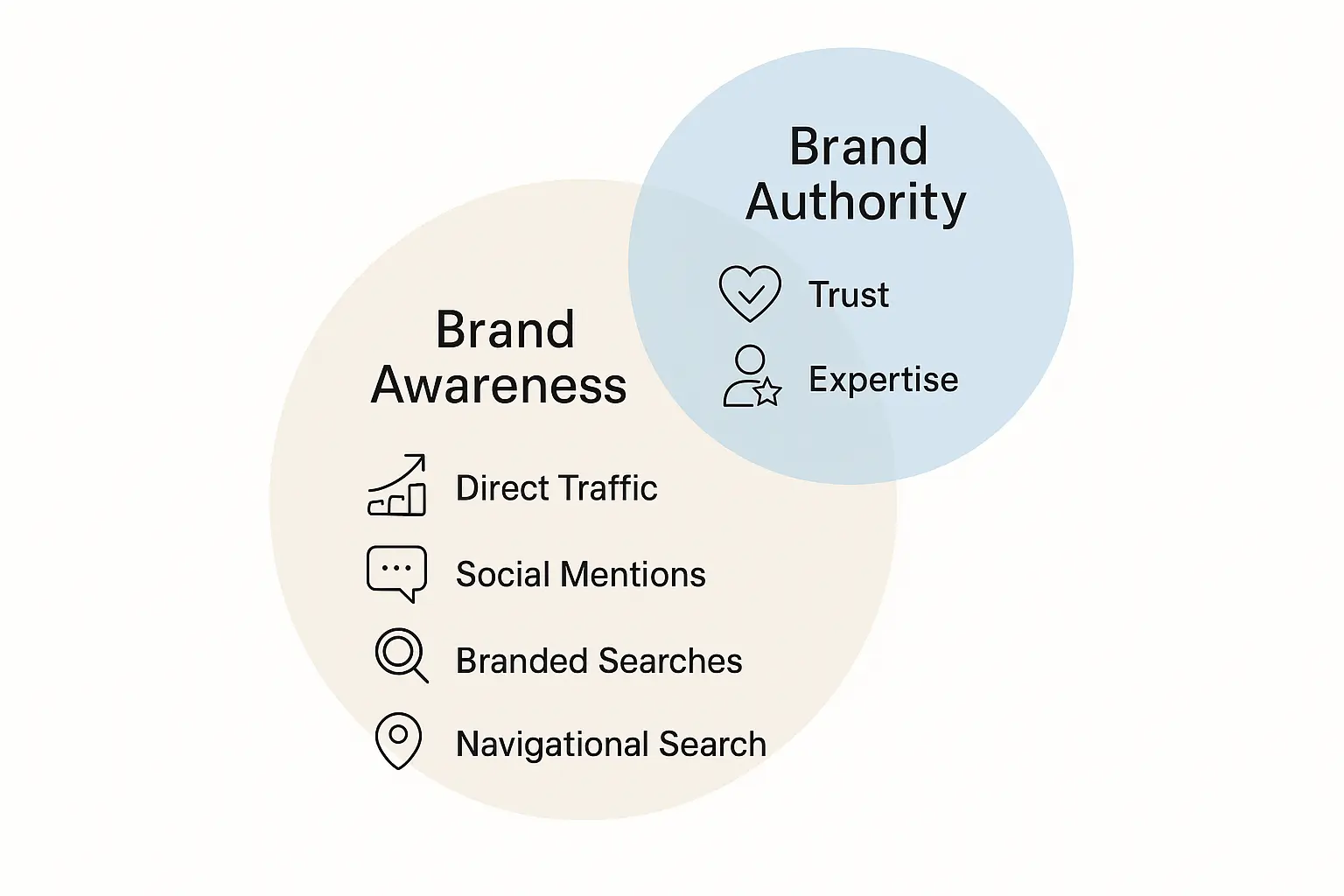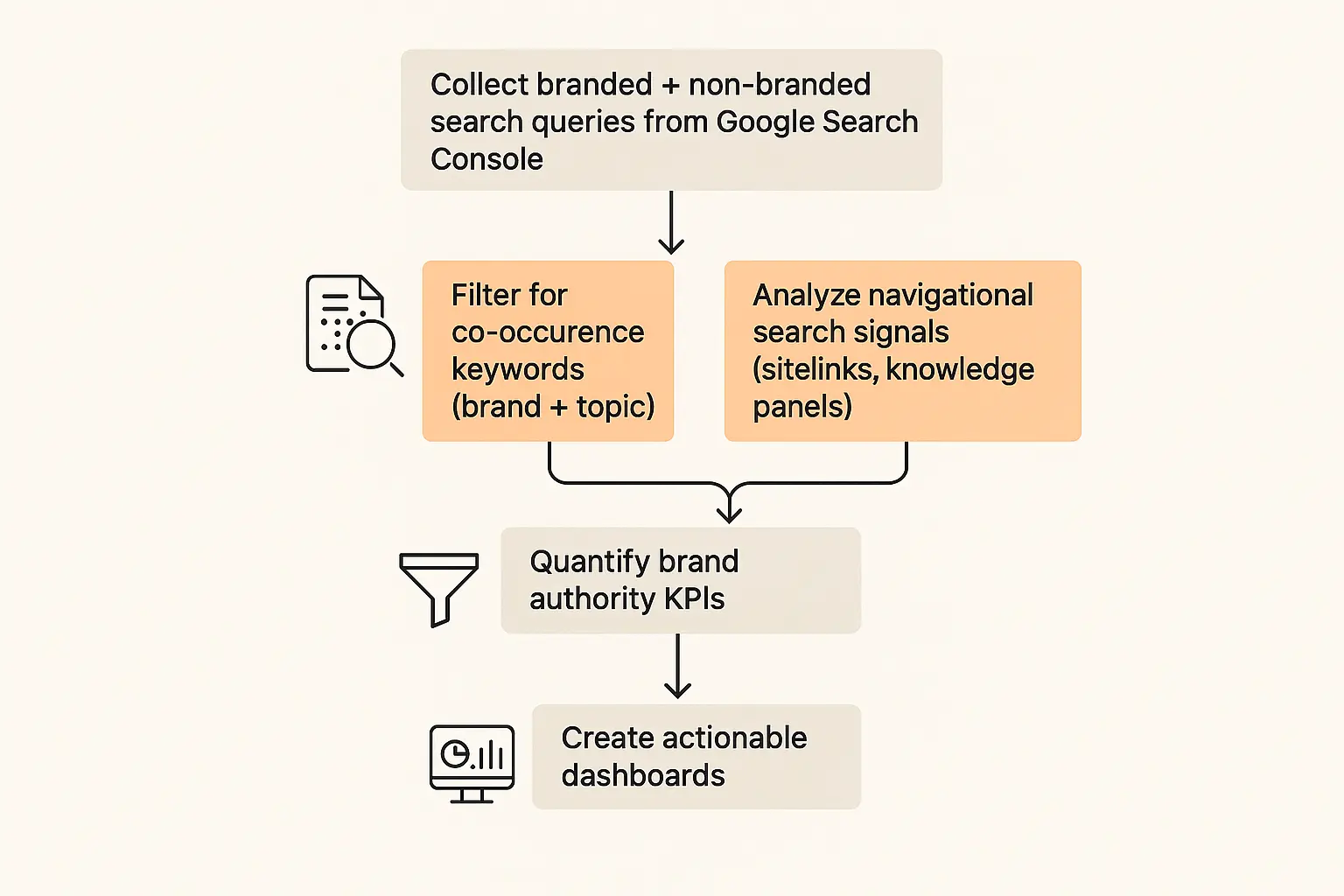You’re staring at the branded search volume report again. For the third month in a row, the line is stubbornly flat. But you know things are happening. The social media team is killing it, a recent PR hit got major buzz, and your client’s name is popping up in all the right conversations.
So, why isn’t this activity showing up in the one metric everyone points to as proof of brand strength?
This is a common frustration. We’re taught to watch branded search volume like a hawk, but relying on it alone is like trying to understand a movie by watching only one scene. It gives you a piece of the story, but you miss the entire plot. Your brand’s growing influence leaves fingerprints all over search data—you just need to know where to look.
The Blind Spot of Traditional Brand Tracking
For years, the go-to KPI for brand awareness in SEO has been simple: the number of people searching for [Your Brand Name]. While this metric isn’t useless, it’s a lagging indicator. It tells you about the brand equity you’ve already built, not the momentum you’re generating right now.
A slow and steady increase in branded search is reassuring, but it fails to capture the subtle shifts in user behavior that signal true brand authority. It misses the context of why people are searching for you.
According to research from SparkToro and Similarweb, “a brand” is the single biggest factor that influences where people click and buy online. If brand is that powerful, we need a more sophisticated way to measure it.
Relying solely on raw branded volume means you’re missing the two most powerful signals of emerging brand authority: co-occurrence and navigational intent.
A Smarter Signal: The Rise of Brand Co-occurrence
Let’s unpack a concept that will change how you see brand building. Brand co-occurrence is when a user searches for your brand name alongside a non-branded, descriptive keyword.
It’s not just “Zendesk”.
It’s “Zendesk for small business”.
It’s not just “Canva”.
It’s “Canva social media templates”.
This is a pivotal moment. When users start attaching your brand name to their problem, it means your brand has become a mental shortcut for a solution. You’re no longer just a company; you’ve become a category leader in the user’s mind.
These co-occurrence searches are a leading indicator of success. They show that your content, social, and PR efforts are working. People aren’t just remembering your name; they’re associating it with their needs.
Co-occurrence queries represent high-intent users who see your brand as the answer. And while BrightEdge notes that organic search drives over 53% of all website traffic, it’s the quality of that traffic that truly matters.

The Ultimate Proof: Mastering Navigational Search Intent
If co-occurrence is the spark, navigational search is the fire. A navigational query is when a user types your brand name into Google simply to get to your website. Instead of typing yourwebsite.com into the address bar, they type “your brand” into the search bar.
Why is this so important? Because it signals absolute top-of-mind awareness. It’s the ultimate act of trust and convenience. The user doesn’t need to remember your URL; they just need to remember you. Your brand has become the destination.
According to data from SEMrush, navigational searches have the highest click-through rate (CTR) of any search type. This makes perfect sense—the user has already decided where they want to go.
When Google sees a high volume of users searching for your brand and clicking only on your result, it sends a powerful signal of authority and trustworthiness. This, in turn, can positively impact your rankings for non-branded keywords.

Connecting the Dots: The Brand-to-Demand Flywheel
So, how do these pieces fit together? They create a powerful, self-reinforcing loop we can call the Brand-to-Demand Flywheel.
Here’s how it works:
-
Build Brand: You invest in activities outside of traditional SEO—podcasts, webinars, community building, social media, PR.
-
Generate Signals: Users see this and start performing co-occurrence and navigational searches. They associate you with their problems and use Google as their GPS to find you.
-
Google Rewards Authority: Google’s algorithm picks up on these strong user intent signals. Your high CTR on these queries demonstrates your relevance and authority.
-
Rankings & CTR Improve: Google begins to favor your site for related non-branded terms, knowing users trust your brand. As you climb the SERPs, your visibility increases—after all, Backlinko data shows the top 3 results get over half of all clicks.
-
More Exposure, Stronger Brand: This increased visibility introduces your brand to new audiences, which feeds back into the top of the flywheel.
This flywheel shows that brand building isn’t separate from SEO; it’s the fuel. It’s a core component of any effective omnichannel growth strategy—the kind that, according to a McKinsey report, helps top brands retain nearly 90% of their customers. Tracking co-occurrence and navigational queries is how you prove these broader efforts are directly impacting search performance.

How to Start Tracking These Metrics Today
You don’t need fancy, expensive tools to uncover these insights. You can get started right now with Google Search Console.
To find co-occurrence queries:
- Open Google Search Console and go to the Performance report.
- Click “+ New” > “Query…”
- Select “Queries containing” and enter your brand name.
- Now, add another filter. Click “+ New” > “Query…” again.
- Select “Custom (regex)” and use a formula to exclude only your brand name. For a brand named “Acme,” the regex might be ^(?!acme$).*. This step filters out simple branded searches, leaving you with a clean list of valuable co-occurrence terms.
To analyze navigational intent:
- In the Performance report, filter for queries containing your brand name.
- Click on the “Pages” tab.
- Look at the top URLs. Is your homepage dominating the clicks? This is a strong sign of navigational intent, confirming that people are searching for your brand name just to land on your front page.
Integrating these views into your regular SEO reporting tells a much richer, more accurate story of brand growth than a simple volume chart ever could.
Frequently Asked Questions (FAQ)
What’s the difference between navigational search and direct traffic?
Direct traffic is when someone types your URL directly into their browser or uses a bookmark. Navigational search is when they use a search engine as a stepping stone to get to your site. While related, navigational search is a specific, measurable signal of brand recall within the search ecosystem itself.
How long does it take to see an impact on these metrics?
It depends on the intensity and success of your brand-building efforts. Unlike technical SEO fixes, this is a gradual process. You might start seeing subtle shifts in co-occurrence queries within a few weeks of a successful campaign, while strong navigational intent can take months to build. The key is to track it consistently.
Can small brands or startups track this too?
Absolutely! In fact, it’s even more important for smaller brands. For a new company, seeing the first few co-occurrence searches like “[Your Brand] vs [Competitor]” or “[Your Brand] for [use case]” is a significant early win and proof that your message is landing.
Is brand co-occurrence just another name for a long-tail keyword?
Not quite. While a co-occurrence query is often a long-tail keyword, the key distinction is the presence of the brand name. A long-tail keyword like “how to create social media graphics for free” is non-branded. A co-occurrence query like “free social media graphics with canva” includes the brand, signaling a much deeper level of awareness and intent.
From Measurement to Momentum
Shifting your focus from simple branded search volume to the richer signals of co-occurrence and navigational intent is more than a reporting change—it’s a strategy change. It allows you to connect the dots between all your marketing efforts and their tangible impact on organic growth.
You can finally build a business case for brand investment, showing stakeholders precisely how that podcast sponsorship or industry webinar is building a moat around your business in the SERPs.
For agencies looking to deliver this level of insight for their clients, exploring a partnership with expert white-label SEO services can be a powerful way to scale this sophisticated approach.
Start looking for these signals today. You’ll stop wondering if your brand is growing and start proving it.

